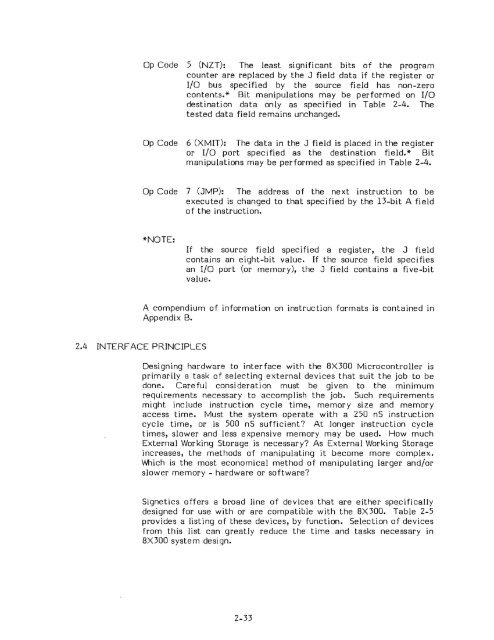8x300 design guide - Al Kossow's Bitsavers - Trailing-Edge
8x300 design guide - Al Kossow's Bitsavers - Trailing-Edge
8x300 design guide - Al Kossow's Bitsavers - Trailing-Edge
Create successful ePaper yourself
Turn your PDF publications into a flip-book with our unique Google optimized e-Paper software.
Op Code 5 (NZT): The least significant bits of the program<br />
counter are replaced by the J field data if the register or<br />
I/O bus specified by the source field has non-zero<br />
contents. * Bit manipulations may be performed on I/O<br />
destination data only as specified in Table 2-4. The<br />
tested data field remains unchanged.<br />
Op Code 6 (XMIT): The data in the J field is placed in the register<br />
or I/o port specified as the destination field.* Bit<br />
manipulations may be performed as specified in Table 2-4.<br />
Op Code 7 (JMP): The address of the next instruction to be<br />
executed is changed to that specified by the 13-bit A field<br />
of the instruction.<br />
*NOTE:<br />
If the source field specified a register, the J field<br />
contains an eight-bit value. If the source field speci fies<br />
an I/O port (or memory), the J field contains a five-bit<br />
value.<br />
A compendium of information on instruction formats is contained in<br />
Appendix B.<br />
2.4 INTERFACE PRINCIPLES<br />
Designing hardware to interface with the 8X300 Microcontroller is<br />
primarily a task of selecting external devices that suit the job to be<br />
done. Careful consideration must be given to the mInImum<br />
requirements necessary to accomplish the job. Such requirements<br />
might include instruction cycle time, memory size and memory<br />
access time. Must the system operate with a 250 nS instruction<br />
cycle time, or is 500 nS sufficient? At longer instruction cycle<br />
times, slower and less expensive memory may be used. How much<br />
External Working Storage is necessary? As External Working Storage<br />
increases, the methods of manipulating it become more complex.<br />
Which is the most economical method of manipulating larger and/or<br />
slower memory - hardware or software?<br />
Signetics offers a broad line of devices that are either specifically<br />
<strong>design</strong>ed for use with or are compatible with the 8X300. Table 2-5<br />
provides a listing of these devices, by function. Selection of devices<br />
from this list can greatly reduce the time and tasks necessary in<br />
8X300 system <strong>design</strong>.<br />
2-33

















